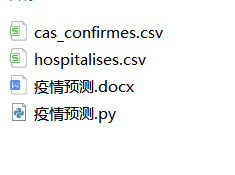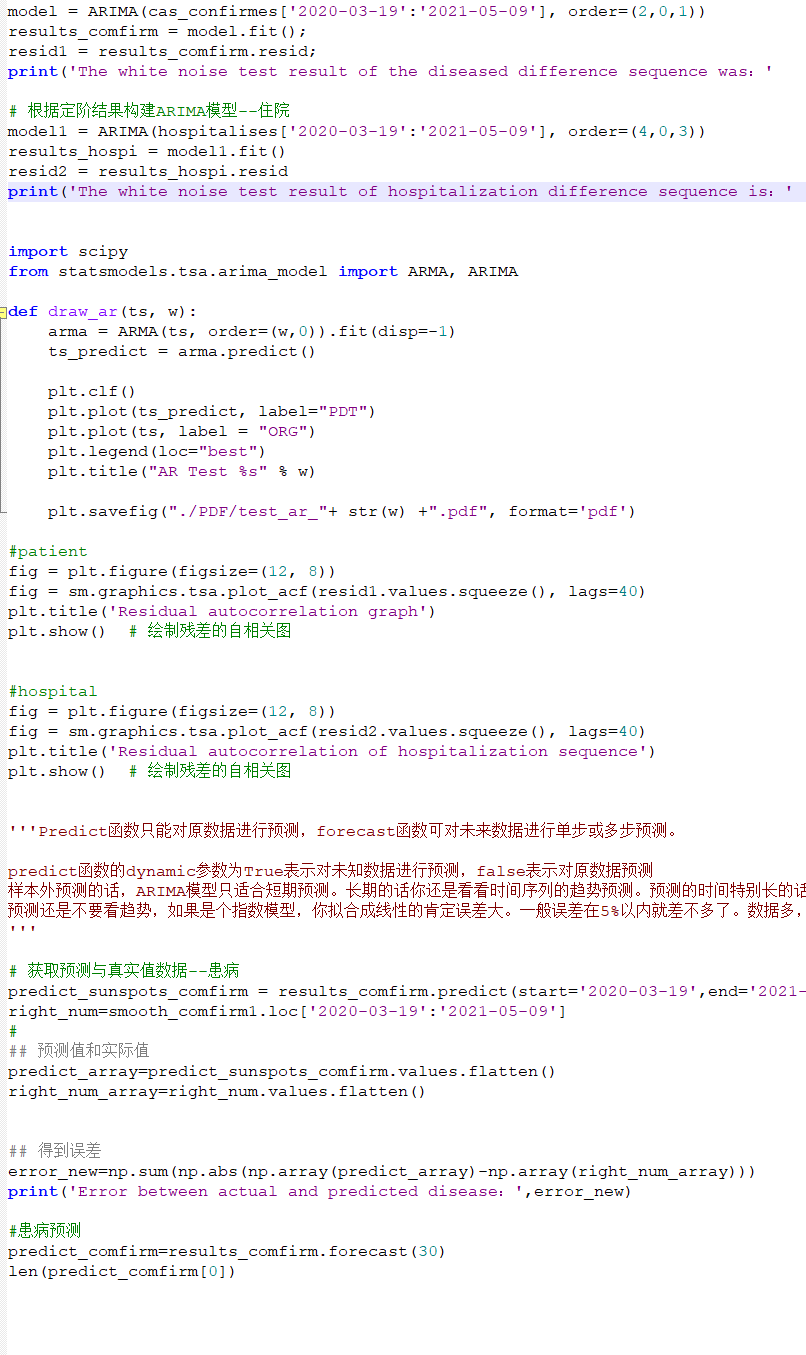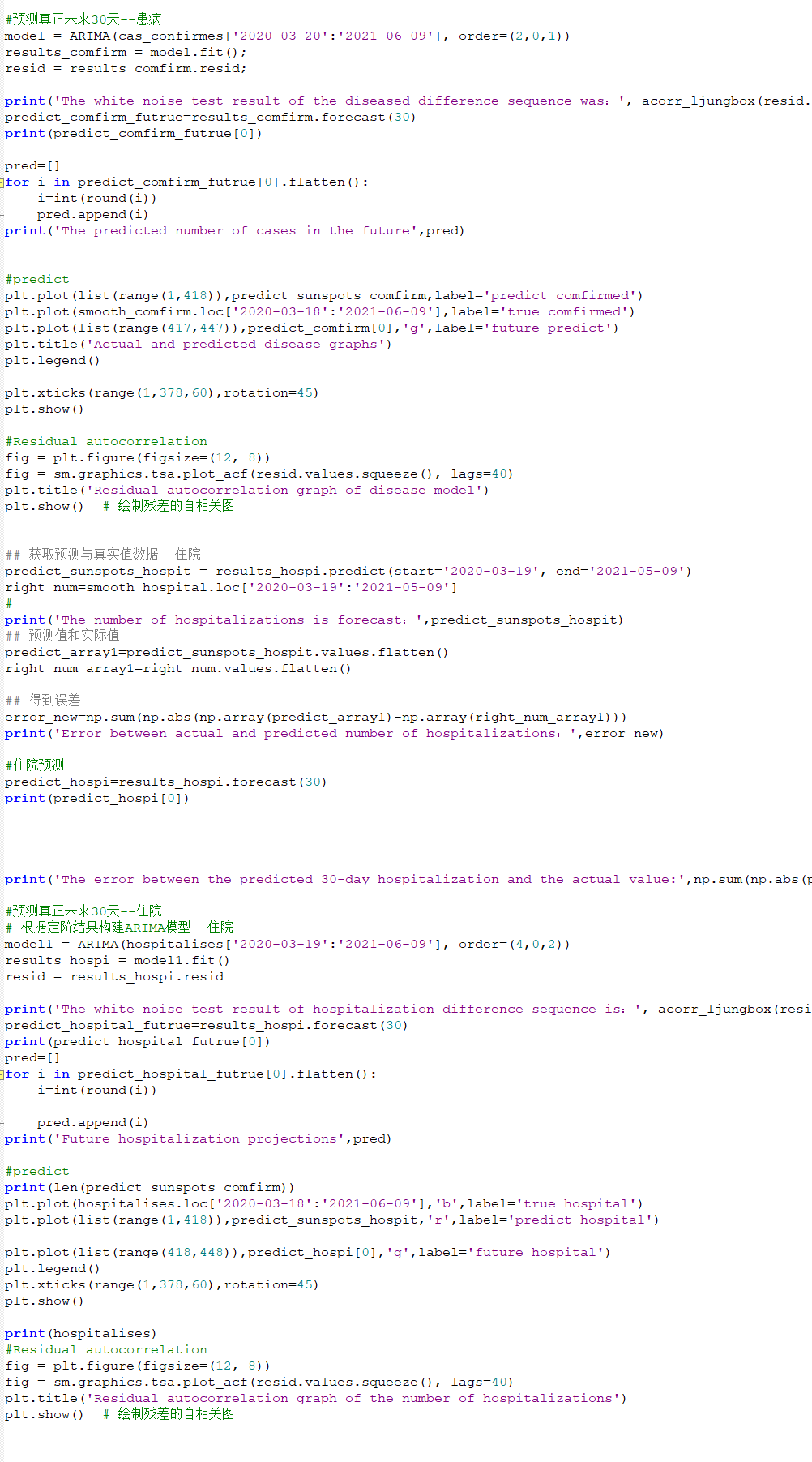资源地址:Python数据分析大作业 2000+字 图文分析文档 疫情分析+完整python代码

数据分析






资源地址:Python数据分析大作业 2000+字 图文分析文档 疫情分析+完整python代码
代码详解



主要是对时间序列数据进行分析和预测。让我们逐步解释每一部分:
-
导入必要的库:
from math import * import numpy as np import pandas as pd import matplotlib.pyplot as plt from statsmodels.graphics.tsaplots import plot_acf, plot_pacf from pylab import *math: 导入数学函数库,但实际上在后续的代码中没有用到。numpy、pandas、matplotlib.pyplot: 分别是用于数值计算、数据处理和可视化的常用库。statsmodels.graphics.tsaplots.plot_acf和statsmodels.graphics.tsaplots.plot_pacf:用于绘制自相关性和偏自相关性图。pylab: 导入了*,所以其下所有函数都可直接使用。
-
设置中文字体和负号显示:
plt.rcParams['font.sans-serif'] = ['SimHei'] # 设置中文字体为黑体 plt.rcParams['axes.unicode_minus'] = False # 解决负号显示问题 -
读取数据:
cas_confirmes = pd.read_csv('cas_confirmes.csv', index_col=0) hospitalises = pd.read_csv('hospitalises.csv', index_col=0)从文件中读取了两个时间序列数据,分别是患病确诊人数和住院人数。
-
数据处理:
cas_confirmes.fillna(np.nanmean(cas_confirmes) + 30 * np.random.random(), inplace=True) hospitalises.fillna(np.nanmean(hospitalises), inplace=True)使用每列的均值填充缺失值。
-
数据可视化:
cas_confirmes.plot() plt.title('Change in the number of cases') plt.show() hospitalises.plot() plt.title('Changes in the number of people in the hospital') plt.show()绘制了患病确诊人数和住院人数的变化趋势图。
-
自相关性分析:
plot_acf(cas_confirmes) plt.title('The autocorrelation of the number of patients') plot_pacf(cas_confirmes) plt.title('Partial autocorrelation of the number of patients') plt.show() plot_acf(hospitalises) plt.title('Autocorrelation graph of the number of people in the hospital') plot_pacf(hospitalises) plt.title('Partial autocorrelation graph of the number of people in the hospital') plt.show()绘制了患病确诊人数和住院人数的自相关性和偏自相关性图。
-
ARIMA 模型定阶:
train_results = sm.tsa.arma_order_select_ic(cas_confirmes['2020-03-19':'2021-06-09'], ic=['bic'], trend='nc', max_ar=5, max_ma=5) print('BIC for the number of patients', train_results.bic_min_order)使用 BIC 准则确定 ARIMA 模型的阶数。
-
构建 ARIMA 模型:
model = ARIMA(cas_confirmes['2020-03-19':'2021-05-09'], order=(2,0,1)) results_comfirm = model.fit();使用确定的阶数构建 ARIMA 模型,并对患病确诊人数和住院人数分别进行建模。
-
模型诊断:
print('The white noise test result of the diseased difference sequence was:', acorr_ljungbox(resid1.values.squeeze(), lags=1)) print('The white noise test result of hospitalization difference sequence is:', acorr_ljungbox(resid2.values.squeeze(), lags=1))对模型的残差进行自相关性分析,检验残差序列是否为白噪声。
-
模型预测:
predict_comfirm=results_comfirm.forecast(30)使用训练好的 ARIMA 模型对未来一段时间内的患病确诊人数和住院人数进行预测。
-
可视化预测结果:
plt.plot(list(range(1,418)),predict_sunspots_comfirm,label='predict comfirmed') plt.plot(smooth_comfirm.loc['2020-03-18':'2021-06-09'],label='true comfirmed') plt.plot(list(range(417,447)),predict_comfirm[0],'g',label='future predict') plt.title('Actual and predicted disease graphs') plt.legend()绘制预测结果和真实数据的对比图。
























 被折叠的 条评论
为什么被折叠?
被折叠的 条评论
为什么被折叠?










